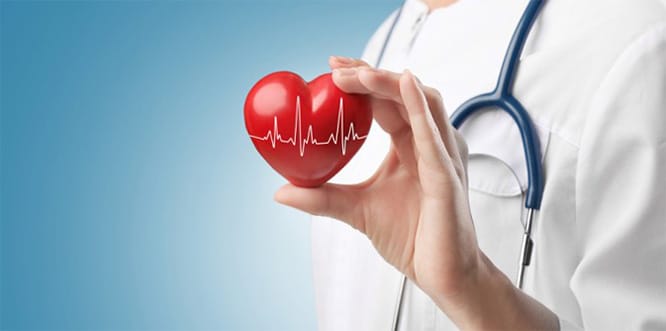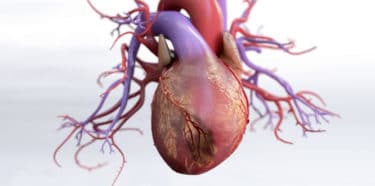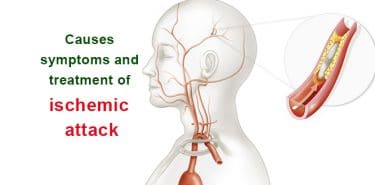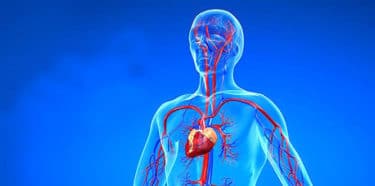Arrhythmia (cardiac arrhythmia) is a disorder of the heart that affects the normal level of heart rate or rhythm. It may occur due to any interruption in electrical impulses that help the heart contract. Many factors including substances such as caffeine, nicotine, alcohol, and inhaled aerosols, diet pills, medications for cough and common cold, heart attack, birth defects or emotions such as excitement, fear, and stress can cause arrhythmia. Symptoms of arrhythmia include palpitations, irregular heartbeat, dizziness, fainting, chest pain, shortness of breath, and sweating. However, these symptoms do not always mean a rhythm disorder. For example, it is normal for the heart to beat fast during an exercise or to slow down during sleeping or deep relaxation. Depending on the type of arrhythmia and the underlying cause, treatment methods may vary. These include antiarrhythmic drugs, pacemaker, surgery, exercise, or changes in lifestyle.
Table of Contents
What is arrhythmia (cardiac arrhythmia)?
Arrhythmia is an abnormality in the rhythm of the heart. It refers to any change in the normal sequence of electrical impulses that regulate heartbeats. A change in electrical impulses can cause the heart to beat too slow (bradycardia), too fast (tachycardia), too early (premature contraction) or irregularly (fibrillation). When the heart is not working properly, it cannot pump blood to the body effectively. The brain, lungs, and other vital organs may become damaged when the blood circulation is blocked. (1)
Causes of arrhythmia
The heart rhythm is controlled by electrical signals. The heartbeat (contraction) begins with an electrical impulse from the sinoatrial node (sinus node). Sinus node is natural pacemaker of the heart. When these electrical impulses do not work properly, problems in the heart rhythm occur.(2)
Common causes of arrhythmia:
- Scar tissue in the heart caused by a heart attack
- Changes in the heart structure such as cardiomyopathy
- Coronary artery disease
- Abnormal heart valve, heart failure
- Recovery process after a heart surgery
- Birth defects
- High blood pressure, diabetes
- Thyroid problems
- Imbalance of the electrolytes in the blood, such as sodium, potassium, calcium and magnesium
- Obstructive sleep apnea
Risk factors of arrhythmia
- Smoking
- Excessive alcohol and caffeine intake
- Substance abuse
- Stress, anxiety
- Several medications for common cold, cough and allergies, and food supplements
- Genetics
Types of arrhythmia
Heart is made up of four chambers: two upper chambers (atria) and two lower chambers (ventricles). Arrhythmias are divided up by where they happen and by the heart rate.
Tachycardia
Tachycardia means a faster heart rate. It is defined as the resting heart rate of more than 100 beats per minute. There are several types of tachycardia which start at the atria and the ventricles.
Supraventricular tachycardia (SVT)
Supraventricular tachycardia is a broad term that includes many forms of arrhythmia originating from the AV node on the ventricles and the atria. These types of arrhythmia cause sudden episodes of abnormally fast palpitations that begin and end abruptly. These episodes can last a few seconds or several hours. The most common type of SVT is atrial fibrillation. (3)
Atrial fibrillation
It is caused by chaotic electrical impulses in the atria. These signals result in rapid, uncoordinated contractions of the atria. As it cannot contract efficiently, the atria vibrate. Atrial fibrillation may be temporary, but if left untreated, serious complications such as stroke may occur.
Ventricular tachycardia (VT)
Ventricular tachycardia starts with abnormal electrical signals in the ventricles. The rapid heart rate does not allow the ventricles to fill and contract efficiently to pump enough blood to the body. Ventricular tachycardia may not cause serious problems in a healthy heart, but those people with the heart problems may need to get medical treatment. (4)
Ventricular fibrillation
Rapid, chaotic electrical impulses cause the ventricles to vibrate ineffectively instead of pumping blood to the body. Blood pressure decreases and if the heart is not restored to a normal level of rhythm within minutes, it may be fatal due to the lack of blood flow to the vital organs.
Bradycardia
Bradycardia is a slower heart rate. A heart rate below 60 beats a minute while resting is considered bradycardia. It does not always signal a problem. Physically fit people may have an efficient heart which is capable of pumping adequate level of blood with fewer than 60 beats a minute at rest.
Types of bradycardia:
- Sinus bradycardia: If the sinus node, which is responsible for setting the heart rate, is not sending impulses properly, the heart may beat too slow or irregularly. It may develop after a heart attack or due to a heart disease. (5)
- Conduction block: If the electrical pathways of the heart is blocked, the chambers contract too slowly. While some blocks show no symptoms, others may be fatal.
Premature heartbeats (Ectopic rhythm)
Normal heart rate is interrupted by a premature beat and an extra beat between normal beats occur. It rarely points at a more serious problem; however, it can trigger a longer lasting arrhythmia in people with a heart disease. It may sometimes be caused by stress, strenuous exercise or stimulants such as caffeine or nicotine.
Symptoms of arrhythmia
- Palpitation
- Irregular heartbeat
- Chest pain
- Dyspnea
- Anxiety, difficulty in concentrating
- Fatigue, dizziness, lightheadedness
- Sweating
- Fainting
- Confusion
Diagnosis of arrhythmia
A detailed physical examination is performed by reviewing a patient’s symptoms and medical history to diagnose arrhythmia. The patient is asked about family history, diet and lifestyle. By conducting follow-up tests specific to arrhythmias, unusual heartbeats are identified and sources or triggers are detected.
The most effective way to diagnose arrhythmia is the electrical recording of the heart rate, called electrocardiogram (ECG). Other tests used to diagnose arrhythmias are: Holter monitor which records heart activity for 1-2 days, cardiac event monitor which records symptoms that occur from time to time, echocardiogram which scans the heart’s movements and its structure, stress tests which monitor heart activity during an exercise, and tilt-table test.
Treatment of arrhythmia
Arrhythmia treatment depends on the type and other underlying causes. Some mild arrhythmias may not require treatment. The treatment methods used in cases with serious risk of complications are: (6)
Drug treatment
Medicines used to control your heart rate or restore normal heart rhythm are often effective in reducing tachycardia attacks.
- Antiarrhythmic drugs: beta-blockers that control the heart rate.
- Anticoagulant or antiplatelet therapy: Blood thinners such as warfarin and aspirin, which are mostly used in arrhythmias such as atrial fibrillation and reduce the risk of blood clots and stroke.
Cardioversion
An electric shock is delivered to the chest wall to synchronize the heart and trigger normal rhythm under anesthesia or sedation. (7)
Catheter ablation
It is a keyhole surgery applied under anesthesia to destroy damaged tissue in the heart. High frequency electrical energy is transmitted to a damaged tissue, which is the source of arrhythmia, with catheters placed in the heart to regulate abnormal heart rate. (8)
Ablation is mostly used to treat PSVT, atrial fibrillation, atrial and ventricular tachycardias. It may also be combined with other procedures.
Implantable devices
- Pacemaker: It is a small device that helps the heart to beat regularly by sending electrical signs. It is placed to the chest under local anesthesia. Slow heart rate (bradycardia) is usually treated with a pacemaker if there are no other underlying causes.
- Implantable cardioverter defibrillator (ICD): An ICD is similar to a pacemaker. It tracks the heart rate and when it detects a very fast rate or unusual rhythm, it delivers an electric shock to the heart muscle to make it beat at a regular rate again. It is mainly used to treat ventricular tachycardia and ventricular fibrillation. It is implanted close to the left collarbone. ICD does not prevent an abnormal rhythm; however, it treats the abnormal rhythm when it occurs.
Surgical procedures
Some arrhythmias occurring in a specific area of the heart may require removal of the area with surgery.
- Maze procedure: This type of surgery is mostly used in the treatment of atrial fibrillation. In this procedure, a series of incisions (maze) are made to the right and left atrium. These incisions become scar tissues and they create blocks that guide the electrical impulses. This makes the heartbeat efficiently. As the scar tissue does not conduct electrical impulses, the stray electrical impulses that cause arrhythmia are prevented.
- Ventricular aneurysm repair: Sometimes, an aneurysm or a bulge in a blood vessel leading to the heart may cause arrhythmia. When other treatment methods are ineffective, aneurysm is removed with surgery.
- Coronary bypass surgery: Arteries or vessels taken from other parts of the body are connected to the coronary arteries with grafts. In this way, blood flow to the heart muscle may be improved by skipping the narrowed arteries during the circulation.
Vagal maneuvers
Certain physical movements and exercises, directed by a specialist, are used in the treatment of several types of arrhythmias such as supraventricular tachycardia. These maneuvers include holding your breath, stretching certain muscles, coughing, or immersing the face in icy cold water. These maneuvers stimulate the vagus nerves, the part of the nervous system that regulate the heartbeat, and slow down your heart rate.
Suggestions for people with arrhythmia
It is vital to maintain a healthy lifestyle to prevent arrhythmia and to reduce the risk of heart disease.
A heart health friendly lifestyle should include:
- Maintain a healthy diet including foods rich in fruits, vegetables and whole grains with lower salt and fats level. Omega-3 fatty acids, found abundantly in fish, are effective in the prevention and treatment of some arrhythmias.
- Doing moderate-intensity exercises for at least 30 minutes regularly helps you stay physically active and maintain a healthy weight. Excess weight increases your risk of developing a heart disease.
- Quit smoking. Limit caffeine and alcohol intake
- Reduce stress as extreme stress and anger can cause heart rhythm problems. Some complementary and alternative therapies such as yoga and meditation can help reduce stress.
- Some studies show that acupuncture can help reduce irregular heart rates in certain arrhythmias.




